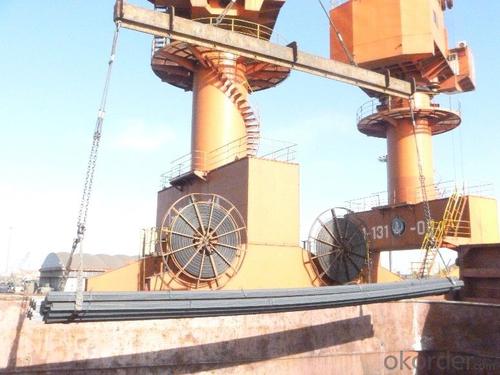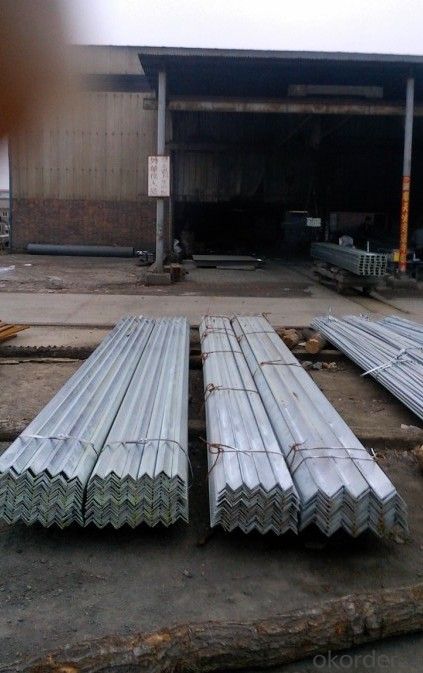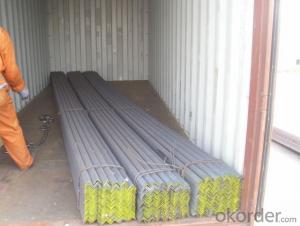GB Q235 Equal Steel Angle
OKorder Service Pledge
OKorder Financial Service
You Might Also Like
Specifications of Equal Angle Steel
1.Standards:GB
2.Length:6m,9m,12m
3.Material:GBQ235,Q345 or Equivalent
4. Size:
Size (mm) | Mass (mm) | Size (mm) | Mass (mm) |
| 25*25*2.5 | 0.95 | 25*25*3 | 1.124 |
| 25*25*2.7 | 1.02 | 25*25*4 | 1.459 |
Usage & Applications of Equal Anlge Steel
Trusses;
Transmission towers;
Telecommunication towers;
Bracing for general structures;
Stiffeners in structural use.
Packaging & Delivery of Equal Angle Steel
1. Transportation: the goods are delivered by truck from mill to loading port, the maximum quantity can be loaded is around 40MTs by each truck. If the order quantity cannot reach the full truck loaded, the transportation cost per ton will be little higher than full load.
2. With bundles and load in 20 feet/40 feet container, or by bulk cargo, also we could do as customer's request.
3. Marks:
Color mark: There will be color marking on both end of the bundle for the cargo delivered by bulk vessel. That makes it easily to distinguish at the destination port.
Tag mark: There will be tag mark tied up on the bundles. The information usually including supplier logo and name, product name, made in China, shipping marks and other information request by the customer.
If loading by container the marking is not needed, but we will prepare it as customer request.
*If you would like to get our price, please inform us the size, standard/material and quantity. Thank you very much for your attention.
- Q: Can steel angles be used in solar panel mounting systems?
- Yes, steel angles can be used in solar panel mounting systems. Steel angles are often chosen for their strength, durability, and stability, making them suitable for supporting the weight of solar panels. They can be easily fabricated and customized to fit specific project requirements. Additionally, steel angles provide a stable base for solar panels, ensuring proper alignment and reducing the risk of damage due to wind or other external factors. However, it is important to consider the specific requirements of the solar panel system and consult with a structural engineer or a professional installer to ensure that the chosen steel angles meet the necessary load-bearing capacity and structural integrity standards.
- Q: Can steel angles be customized or fabricated to specific requirements?
- Yes, steel angles can be customized or fabricated to specific requirements. Steel angles are versatile and can be easily modified to meet different specifications and applications. Fabrication processes such as cutting, drilling, welding, and bending can be used to customize steel angles to the desired shape, size, and dimensions. This allows for the creation of steel angles with specific lengths, thicknesses, and angles to meet the unique requirements of different construction or engineering projects. Customized steel angles can be used in various applications, including structural framing, supports, brackets, reinforcements, and architectural designs. Overall, steel angles offer flexibility in customization and fabrication, making them suitable for a wide range of construction and industrial needs.
- Q: How do steel angles perform under lateral or wind loading conditions?
- Due to their strength and versatility, steel angles find widespread use in construction and engineering. They excel in handling lateral or wind loading conditions, demonstrating exceptional performance. When subjected to lateral forces acting horizontally and perpendicular to their axis, steel angles exhibit remarkable rigidity and resistance to bending. Consequently, they can withstand substantial lateral loads, making them perfect for applications such as bracing systems, support structures, and framing components that need to resist wind, seismic, or other lateral forces. Similarly, steel angles prove their excellence in wind loading conditions. As wind exerts a strong lateral force on structures, steel angles effectively counteract these forces. By securely fastening steel angles to the structure, stability is ensured, preventing wind-induced vibrations or even collapse. To enhance the performance of steel angles under lateral or wind loading conditions, proper design and installation are crucial. Engineers take into account factors like angle size and thickness, steel type and quality, as well as connection details. By carefully analyzing specific loading conditions and selecting the appropriate steel angles, engineers guarantee that structures remain stable and safe, even under extreme lateral or wind loads. In conclusion, steel angles are highly reliable and durable in handling lateral or wind loading conditions. Their robustness, coupled with their cost-effectiveness and ease of installation, makes them a favored choice in numerous construction and engineering projects.
- Q: What are the typical lead times for steel angle orders?
- The typical lead times for steel angle orders can vary depending on several factors. Generally, lead times for standard steel angles that are readily available in stock can range from a few days to a week. This is because these standard sizes are commonly produced and kept in inventory by steel suppliers. However, if the steel angle order requires specific dimensions, finishes, or special requirements, the lead times can be longer. Custom or non-standard steel angles may need to be fabricated or sourced from mills, which can add additional time to the order fulfillment process. Lead times for such orders can range from a few weeks to several months, depending on the complexity of the specifications and the availability of the required materials. It is important to note that lead times can also be influenced by external factors such as market demand, production schedules, and transportation logistics. Therefore, it is recommended to communicate with the steel supplier or manufacturer to get an accurate estimation of the lead times for specific steel angle orders.
- Q: How do steel angles perform under cyclic or alternating loading conditions?
- Steel angles generally perform well under cyclic or alternating loading conditions. Due to their structural shape and material properties, steel angles have good resistance to fatigue and can withstand repeated loading without significant loss of strength or deformation. Their high strength and stiffness make them suitable for applications that involve cyclic loading, such as in construction and engineering structures. Additionally, steel angles have the advantage of being relatively easy to fabricate and install, making them a popular choice in various industries.
- Q: Can steel angles be used for manufacturing decorative brackets?
- Yes, steel angles can be used for manufacturing decorative brackets. Steel angles are versatile and can be easily fabricated into various shapes and sizes, making them suitable for creating decorative brackets. The angles can be cut, welded, and formed into different designs to achieve the desired aesthetic appeal. Furthermore, steel angles offer strength and durability, ensuring that the decorative brackets can support the weight of the objects they hold. Whether it is for architectural purposes or home décor, steel angles provide a reliable and cost-effective option for manufacturing decorative brackets.
- Q: What are the common applications of steel angles in architecture?
- Steel angles are widely used in architecture for various applications due to their versatility and strength. Some common applications of steel angles in architecture include: 1. Structural support: Steel angles are often used as structural support elements in building construction. They can be welded or bolted together to form a sturdy framework that provides strength and stability to the structure. 2. Framing: Steel angles are commonly used in framing applications such as door and window frames, as well as in the construction of roof trusses. They provide rigidity and support to the overall structure, ensuring that it remains stable and durable. 3. Reinforcement: Steel angles are often used to reinforce concrete structures. They can be embedded into concrete walls, columns, and beams to enhance their load-bearing capacity and resistance to deformation. 4. Staircases and handrails: Steel angles are frequently used in the construction of staircases and handrails. They provide a strong and durable framework that ensures the safety and stability of these architectural elements. 5. Architectural detailing: Steel angles are also utilized for architectural detailing purposes. They can be used to create decorative elements such as cornices, brackets, and ornamental features that add aesthetic appeal to the building. 6. Industrial applications: Steel angles find application in industrial settings, such as factories and warehouses, where they are used to create sturdy platforms, mezzanines, and equipment supports. Overall, steel angles are a versatile and reliable material that offers numerous benefits for architectural applications. Their strength, durability, and flexibility make them an ideal choice for a wide range of architectural structures and features.
- Q: What are the different types of steel angles connections for roof trusses?
- There are several different types of steel angle connections that are commonly used for roof trusses. These connections are designed to provide strong and stable support for the trusses, ensuring the structural integrity of the roof. One common type of steel angle connection is the gusset plate connection. This involves using steel plates, typically in a triangular shape, to connect the various members of the truss at their intersection points. The gusset plates are usually welded or bolted to the steel angles to create a secure connection. Another type of steel angle connection is the angle cleat connection. In this type of connection, steel angles are used to connect the truss members using bolts or welding. The angles are typically bolted or welded to the top and bottom chords of the truss, providing additional strength and stability. A third type of steel angle connection is the angle clip connection. This involves using steel clips or brackets to connect the truss members at their intersection points. The clips are typically bolted or welded to the steel angles, creating a strong and secure connection. Finally, there is the angle bracket connection. This type of connection involves using steel brackets or brackets to connect the truss members. The brackets are typically bolted or welded to the steel angles, providing a reliable and sturdy connection. Overall, there are various types of steel angle connections that can be used for roof trusses, each offering different advantages and characteristics. The specific type of connection used will depend on factors such as the design requirements, load-bearing capacity, and construction methods.
- Q: Are steel angles suitable for coastal or saltwater environments?
- Yes, steel angles are suitable for coastal or saltwater environments. They are widely used in various marine applications due to their excellent corrosion resistance properties. The alloying elements in steel angles, such as chromium and nickel, help to protect against rust and corrosion caused by exposure to saltwater or high humidity. Additionally, proper maintenance and coatings can further enhance their durability in these environments.
- Q: How do you determine the appropriate thickness of a steel angle for a specific application?
- To calculate the suitable thickness of a steel angle for a specific purpose, several factors must be taken into consideration. Firstly, it is crucial to comprehend the load or weight that will be exerted on the steel angle. This includes both the static load, which refers to the continuous weight the angle will bear, and the dynamic load, which signifies any intermittent additional force. The magnitude of the load will determine the strength requirements of the steel angle. Secondly, the length of the steel angle needs to be accounted for. Longer angles will experience more deflection and bending, thus necessitating a thicker angle to ensure adequate rigidity and prevent deformation under the load. Another critical factor to consider is the type of steel being utilized. Different steel grades possess varying strength properties, and the appropriate thickness will depend on the specific grade. It is essential to consult the material specifications and standards to ensure the selected steel angle meets the necessary strength and durability criteria for the intended application. Additionally, the support conditions and the method of attachment should be taken into account. The manner in which the steel angle is connected to other structural elements will impact its load-bearing capacity. If the angle is bolted or welded to other components, its thickness must be selected to suit the particular connection method and accommodate any additional stresses induced during the attachment process. Lastly, it is important to adhere to any applicable industry standards, codes, or regulations when determining the suitable thickness of a steel angle. These standards often provide guidelines or calculations for selecting the correct size and thickness based on the intended application, load, and other design factors. In conclusion, determining the appropriate thickness of a steel angle for a specific application necessitates considering factors such as the load magnitude, length, steel grade, support conditions, and attachment method. Consulting material specifications, industry standards, and seeking professional advice can ensure that the chosen steel angle meets the required strength and durability specifications.
Send your message to us
GB Q235 Equal Steel Angle
OKorder Service Pledge
OKorder Financial Service
Similar products
Hot products
Hot Searches
Related keywords



























